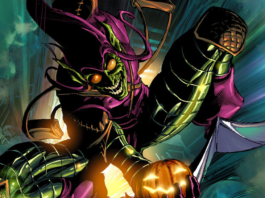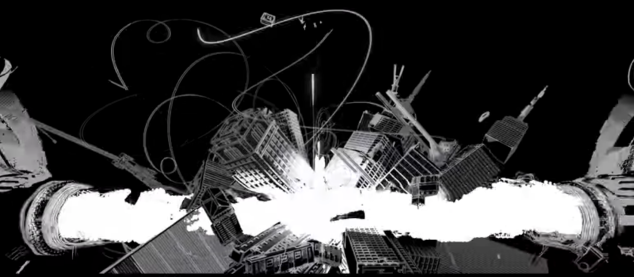Spider-man Into The Spider-verse Coloring

by Nick Nowicki
Spiderman: Into the Spiderverse is a superhero film that tries to emulate the experience of reading a superhero comic book. The film moves away from the live-action superhero paradigm and fills the screen with bold colors, halftoned graphics, and word-boxes that one would see in the comics. Color in particular plays a variety of roles in establishing character traits and developments throughout the film. This post analyzes three main uses of color in the film. First, I will examine how color is used to establish good and evil figures in the film. Next, I will focus on how color is used to emphasize the emotions of characters and the overall tone of a scene. Finally, I analyze the role that color plays in signifying turning points in the narrative arc and various character arcs.
Background on Comic Book Color
Four colors serve as the basis for most of the colors we see in early comic book prints and Into the Spiderverse: cyan, magenta, yellow, and black. The CMYK color model (K being a "key" color, black) stands in contrast to the RGB model, as cyan, yellow, and magenta subtract red, blue, and green from white light, respectively. So, instead of white being the sum of our basis colors, as is the case in RGB, combining cyan, magenta and yellow produces black. It was of course cheaper to simply print pure black instead of combining all three inks.

To produce an RBG color of a particular saturation, illustrators use a process called halftoning where small dots of each CYAM color printed over each other.

Color: Separating Superhero from Supervillain
Audience members without any knowledge of Spiderman or comic books in general can look to a character's color palette to see if that character is good or evil. Heroes tend to have lighter, brighter colors like red, pink, white, and blue while villains tend to have darker, unnatural looking colors like black, purple, or green. The one exception in Into the Spiderverse is the color black, since Spider-Noir, Miles, and Gwen all have black in their costumes.


Into the Spiderverse cleverly uses these colors to give the viewer an early indication of the "bad guys." Miles' uncle, Aaron, is introduced as the "cool uncle" who is not as uptight as Miles' father. When Miles visits Uncle Aaron for the first time, we get clues from his apartment that he might be a supervillain. As Miles looks up to his uncle's apartment from the street, the light coming from his apartment gives the surrounding outdoor objects like the fire escape and building edges a purple tint.
When Miles sends Aaron a picture from his window, the phone screen and background is tinted purple. The purple furniture like Aaron's sofa gives another signal that he might be some kind of "bad guy" in a sense not imagined by Miles' father. Of course, we later find out that Uncle Aaron is the Prowler, whose costume uses purple and black as its primary colors.



The color scheme used in Dr. Olivia Octavius' lab also indicates that she might not be just a doctor who is working for the villains in the movie, but a supervillain herself. As Miles approaches her lab through the vent, the light from the interior of the lab gives the vent a light green tint. We see the same unnaturally green color coming from objects in her lab such as her computer screen and testing chair. Her second primary color is purple, another classic supervillain color that can be seen in her hair, skirt, and surrounding items in the room. These colors are all introduced to the viewer before she reveals herself as Doc Oc, allowing the viewer to foreshadow her reveal.



Color: An Indicator of Emotion
After Miles gains his Spidey powers, his emotions manifest themselves on the screen in various ways. One of the most prominent reoccurring feelings throughout the film is Miles' fear when overwhelmed by social pressure or danger. This fear causes a fight or flight response in Miles, usually triggering some Spidey power like invisibility. We also see the color scheme change at these points where Miles feels overwhelmed.
A good example is early on in the film when Miles sees that everybody in school has heard about him accidentally ripping Gwen's hair out. In the style of a comic book, the screen becomes populated with boxes that show what Miles is afraid of: all the other students judging him and gossiping about him. Just as Miles is overwhelmed by the situation, the colors are intentionally overwhelming to match Miles' emotional state. Pure cyan, magenta, and yellow are scattered in different boxes throughout the screen and jump out at our eyes.

We see this appearance of the classic comic book color palette again when Miles is tested by the Spideys from each dimension at Aunt May's house. When he fails to control his powers and fight back, Miles is knocked to the ground and colors seem to blur off of his body before his invisibility kicks in and he flees the scene. Again, the viewer is overwhelmed with bold primary colors to display Miles' inner anxiety about achieving what is expected of him.

The color blue is also used to set the tone of sad moments in the film. When the original Peter Parker dies at the hands of Kingpin, Miles runs home to his parents, who find out about Parker's death as it is broadcasted on the news. The light from the television screen tints the apartment blue, and we next see the entire city tinted a similar blue as everyone sees the announcement of Parker's death. The creators of Into the Spiderverse were not bounded by realism that live-action filmmakers are limited to, in trying to give a scene its emotional tone. Along with sad music, this blue tint further emphasizes the sadness of the city in response to the death of their hero.

Color and Character Arcs
The main and supporting protagonists possess a set of primary colors that establish a part of their identities. When a character's primary colors are emphasized or changed in some way, this change in color has a corresponding character development. Two key examples of this are in Spider-Man Noir and Miles' character development.
Spider-Man Noir is introduced as a man whose life of fighting crime has led to become hardened and devoid of emotion. The black and white coloration of his universe reflects the fact that he does not have the ability to feel feelings. In this new universe, he discovers that he is not the "one and only" Spider Man, but that there are many others like him that share some variant of his experiences. At the film's climax, we see that he has developed the capacity to have and share emotions. As Penni's robot dies, he is behind her with his hand on her shoulder to comfort her. Before returning he says with hesitation in his voice and the Rubix cube in his hand:
"I…love you all. I'm taking this cube thing with me. I don't understand it, but I will."
When we see him one last time during the resolution of the film, he has solved the cube, the one colorful item in his colorless world. The interplay of colors with their absence (in the RBG system) serves as a symbol of Spider-Man Noir's character change.

Miles' main character development in the film is defined by ability to harness the Spider powers that have been granted to him. Miles struggles with this challenge as he tries to learn how to be Spiderman from Peter, but cannot hone his powers successfully. He has no set of defining colors for most of the film. He tries to emulate Peter's look with a red and blue Spiderman costume that does not fit him. The scene where Miles manages to hone his power and swing throughout the city with his new red and black costume solidifies his new identity as a true superhero. His true colors, red and black, are revealed to us, and we see a new Spiderman comic book falling onto the stack of others.

Color at the Climax
At the climax of the film, the collider beam shoots out cyan, magenta, yellow, and many other combinations to represent the colors in all the universes in a kaleidoscopic way. The energy of the scene is matched by the vibrancy of each character's main color or color scheme. We can see this additional vibrancy first in the fight scene with Doc Oc. At other points in the film, her green appearance is dampened by the surrounding colors. However, when she is in focus during the final fight with Spiderman, her green color is amplified by the presence of the collider beam and fills the entire screen. The peak intensity of her primary color is seen at the peak of her action in the film.

Further, the final return of each Spidey to their respective universe is established by the use of color in the collider beam, rather than bringing the audience to each character's universe. When Spider-Man Noir jumps into the beam, the room lights up in his primary colors: black and white. When Penni and Porker do the same, we see the room filled up with the color schemes of her robot, and the Looney Tunes world, respectively.



Finally, Miles' primary colors permeate the screen during his final fight with Kingpin. Miles' greatest power is on display just as his primary colors are displayed in their purest, most vibrant form, filling the entire "space" of the collider room.


Conclusion
Into the Spiderversebombards the eyes of its viewers with the kinds of bright, robust colors one would see in a comic book. However, it does not do this for no reason. Other than honoring the medium from which the character Spiderman came from, color can be seen as a mechanism for differentiating good from evil, revealing a character's emotions, and signifying character development.
Spider-man Into The Spider-verse Coloring
Source: https://intermittentmechanism.blog/2019/12/13/color-in-spiderman-into-the-spiderverse/
Posted by: ferrelltwoned.blogspot.com

0 Response to "Spider-man Into The Spider-verse Coloring"
Post a Comment